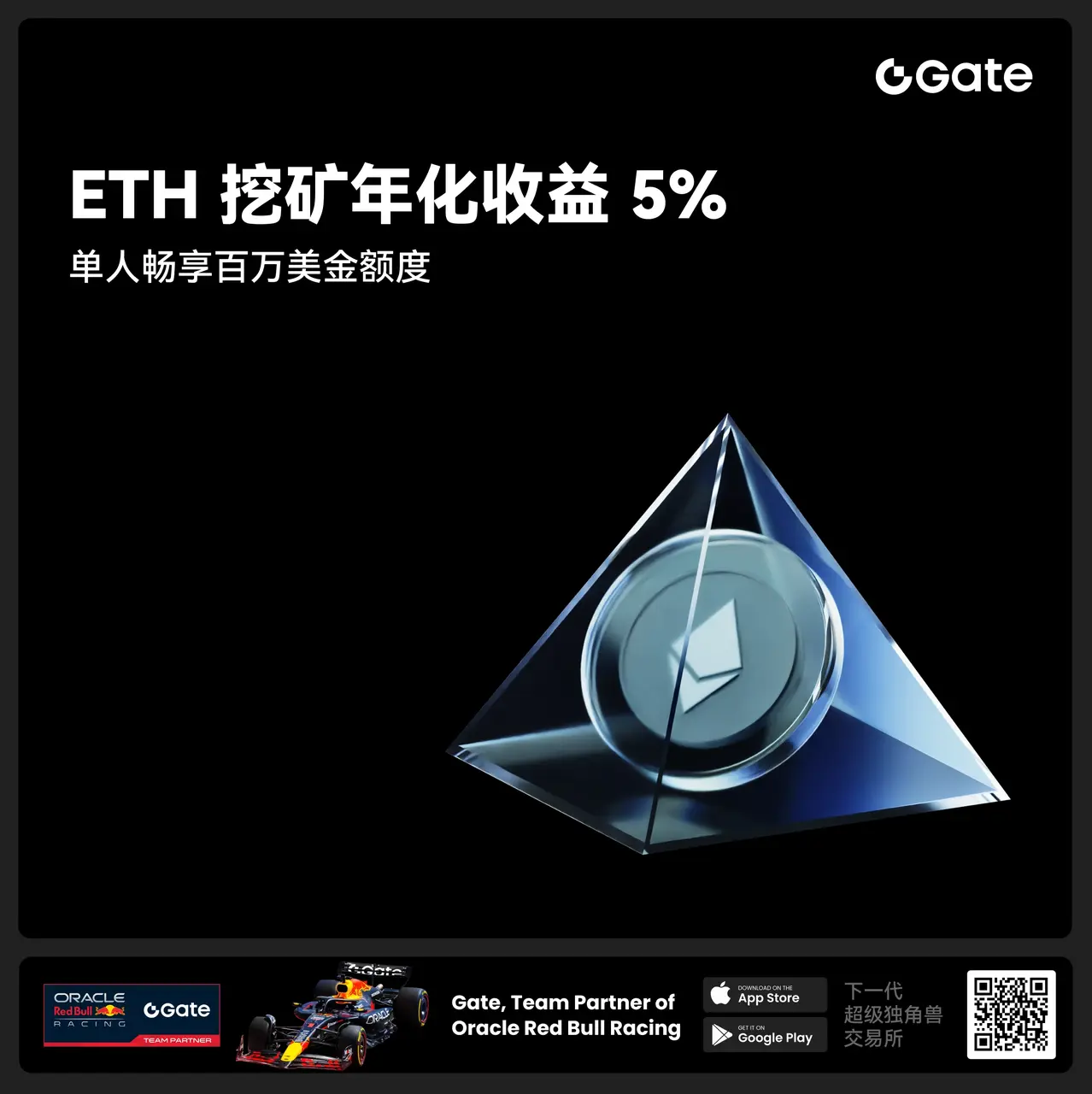- 話題1/3
20418 熱度
35948 熱度
800 熱度
177 熱度
47 熱度
- 置頂
- Gate 鏈上賺幣:ETH 挖礦限時高收益!
✅ 年化收益近 5% + 額外獎勵單人額度 1000 ETH
💎 最低 0.00000001 ETH 起投,無贖回期,隨存隨取!
立即上車,穩賺鏈上收益:https://www.gate.com/staking/ETH
- Gate 合約開倉激勵計劃火熱上線!零門檻瓜分 50,000 ERA
開倉即有獎,交易越多獎勵越多!
新用戶享 20% 加成!
立即參與:https://www.gate.com/campaigns/1692?pid=X&ch=NGhnNGTf
活動詳情:https://www.gate.com/announcements/article/46429
#Gate # #合约交易 # #ERA#
- 👀 家人們,最近你們都攢了多少 Alpha 積分啦?
空投領到了沒?沒搶到也別急,廣場給你整點額外福利!
🎁 曬出你的 Alpha 收益,咱們就送你$200U代幣盲盒獎勵!
🥇 積分最高曬圖用戶 1 名 → $100 代幣盲盒
✨ 積分榜前五優質分享者 5 名 → 各得 $20 代幣盲盒
📍【怎麼玩】
1️⃣ 帶上話題 #晒出我的Alpha积分收益# 發廣場貼
2️⃣ 曬 Alpha 積分截圖 + 一句話總結:“我靠 Gate Alpha 賺了 ____,真的香!”
👉 還可以分享你的攢分技巧、兌換經驗、積分玩法,越乾貨越容易中獎!
📆【活動時間】
8月4日 18:00 - 8月10日 24:00 (UTC+8)
- 🎉 #CandyDrop合约挑战# 正式開啓!參與即可瓜分 6 BTC 豪華獎池!
📢 在 Gate 廣場帶話題發布你的合約體驗
🎁 優質貼文用戶瓜分$500 合約體驗金券,20位名額等你上榜!
📅 活動時間:2025 年 8 月 1 日 15:00 - 8 月 15 日 19:00 (UTC+8)
👉 活動連結:https://www.gate.com/candy-drop/detail/BTC-98
敢合約,敢盈利
- 🎉 攢成長值,抽華爲Mate三折疊!廣場第 1️⃣ 2️⃣ 期夏季成長值抽獎大狂歡開啓!
總獎池超 $10,000+,華爲Mate三折疊手機、F1紅牛賽車模型、Gate限量週邊、熱門代幣等你來抽!
立即抽獎 👉 https://www.gate.com/activities/pointprize?now_period=12
如何快速賺成長值?
1️⃣ 進入【廣場】,點擊頭像旁標識進入【社區中心】
2️⃣ 完成發帖、評論、點讚、發言等日常任務,成長值拿不停
100%有獎,抽到賺到,大獎等你抱走,趕緊試試手氣!
截止於 8月9日 24:00 (UTC+8)
詳情: https://www.gate.com/announcements/article/46384
#成长值抽奖12期开启#
Sui Name Service (NS) 暴漲,項目潛力爆發還是曇花一現?
撰文:Luke,火星財經
引言
NS 代幣在短短一小時內暴漲 103%,價格突破 0.43 USDT,隨後略有回落,目前報 0.38 USDT。這一波漲幅引發了廣泛關注,也讓不少散戶感到驚訝:一個原本不太為人所知的區塊鏈域名代幣,為什麼會突然成為市場焦點?本篇文章將深入分析 NS 的技術優勢和經濟模型,並對比 Ethereum Name Service(ENS),最後探討區塊鏈域名賽道是否具有投資潛力。
巨鯨清算引發的暴漲
NS 的暴漲並非完全由代幣經濟模型推動,而是由巨鯨的資金操作所引發,這種情形與過去的 GameStop 事件頗為相似。當時,巨鯨通過大規模補倉和空投倉位,迅速製造了市場的短期熱潮。
某巨鯨在 2025 年初將資金投入 Navi 平臺,並用 NS 作為貸款抵押,同時在交易所進行空頭操作。巨鯨先是借出 NS、賣空,再用所得利潤償還貸款並重新抵押 NS,形成了一個不斷循環的資金操作。然而,這種操作的空間已經逐漸枯竭。如果其他投資者開始提取他們在 Navi 上的 NS,巨鯨的空頭倉位可能會遭遇快速清算。
根據鏈上數據,2 月 20 日的暴漲正是由於一頭或一組巨鯨通過每分鐘回購 75,000 枚 NS,試圖回補空頭倉位並償還貸款,這一操作引發了價格的劇烈波動。而在這個過程中,散戶的聯合反擊起到了推波助瀾的作用,類似於股市中的「擠壓」效應,導致價格一度飆升至 0.43 USDT。
這種局面雖然看似給了散戶短期盈利的機會,但也隱藏著較大的風險。巨鯨的補倉和空投行為,可能會在市場上形成一個不穩定的資金循環,而如果散戶和投資者紛紛提取他們的 NS,巨鯨的空頭倉位可能會被迅速清算,進而加劇價格波動。因此,這種類型的市場暴漲,既是機會,也可能是一場泡沫。
NS 是什麼?Sui 生態裡的區塊鏈域名服務
Sui Name Service(NS)是 Sui 生態中的一項核心技術,它為用戶提供了一種簡單易記的區塊鏈地址解決方案。在區塊鏈世界中,長串的地址往往讓人頭痛,而 NS 的目標就是讓這些複雜的地址變得更加簡潔和易於識別。例如,Sui 上的地址「0xd77861e972e02feb0927611eb934b67a1f9e60782e36cdef61f6779919b6a8cd」可能讓你感到困惑,但通過 NS,你可以將其轉換為類似「@john」或「john.sui」的簡短標識符,類似於你在社交媒體上創建用戶名,只不過它完全去中心化,運行在 Sui 區塊鏈上。
由 Mysten Labs 團隊開發,NS 利用 Sui 區塊鏈的高性能架構,提供高達每秒 10 萬筆交易的速度,使其具備了處理大量交易的能力。用戶只需支付約 20 SUI(摺合幾美元)便能註冊一個域名,而 2024 年 6 月的 V2 升級還加入了子域名功能,使得命名更加靈活,類似於「@john.family」。NS 的核心使命就是為 Web3 提供一個去中心化的「域名黃頁」,為區塊鏈世界提供更加便利的數字身份和資產管理。
NS vs. ENS:新秀與老大哥的較量
要理解 NS 的潛力,我們不妨將其與區塊鏈域名領域的老牌巨頭 ENS 進行對比。ENS,作為 Ethereum 生態中的核心項目,早在 2021 年便已穩居域名市場的霸主。它為用戶提供了像「vitalik.eth」這樣的簡潔地址,憑藉以太坊龐大的生態系統和先發優勢,ENS 成為區塊鏈世界中最受歡迎的域名服務。ENS 至今已經註冊了超過 260 萬個域名,價格從最初的 43 美元一路飆升至 2021 年 11 月的 85.69 美元,隨後因熊市回調至 6.7 美元(2023 年 10 月),如今恢復在 25-35 美元區間。
但 ENS 也面臨著一些挑戰。最顯著的短板是高昂的 Gas 費用,這使得每年的域名註冊成本常常高達 5 到 640 美元,而短域名尤為昂貴,動輒需要支付 300 ETH(數十萬美元)。此外,由於以太坊的交易速度和手續費問題,ENS 的註冊和使用成本對於普通用戶來說相對較高。
與 ENS 不同,NS 在 Sui 區塊鏈上運行,具有顯著的優勢。Sui 以其高性能的交易架構著稱,交易速度能夠輕鬆達到每秒 10 萬筆,這使得 NS 在成本和效率上都有了巨大的優勢。NS 註冊一個類似於「@john」的域名只需幾美元,而其 Gas 費用幾乎可以忽略不計。得益於 Sui 生態的快速發展和低成本優勢,NS 很可能在新興市場中取得迅猛增長。
然而,NS 的生態尚不如 ENS 成熟,用戶基礎和市場規模遠遠落後於 ENS,散戶投資者需要保持耐心,等待其在生態系統中的逐步發展。
域名賽道:Web3 的「身份證熱」,潛力與風險並存
區塊鏈域名正在迅速成為 Web3 生態的基礎設施之一,類似於傳統互聯網中的域名系統(DNS)。它不僅簡化了複雜的區塊鏈地址,也為去中心化應用(DApp)、NFT 和數字資產提供了去中心化、可驗證的身份系統。就像 1990 年代的.com 域名成為互聯網的稀缺資產一樣,區塊鏈域名可能成為 Web3 領域中的「數字身份證」,隨著 Web3 用戶數的激增,區塊鏈域名的市場需求也將水漲船高。
在這個領域,NS 和 ENS 代表了兩種不同的競爭策略。ENS,作為 Ethereum 生態中的領先者,憑藉以太坊強大的生態系統和先發優勢,成為了區塊鏈域名的「老大哥」。它目前註冊了超過 260 萬個域名,並通過其集成的錢包、DApp 和 NFT 用途牢牢鎖定了高端市場。儘管如此,ENS 的高 Gas 費用和較高的註冊成本仍然是其主要短板,尤其對於普通用戶而言,域名註冊成本較高。
相較之下,NS 依靠 Sui 區塊鏈的高性能和低成本優勢,在市場上展現了強勁的競爭力。Sui 區塊鏈的交易速度極快,註冊一個域名的費用僅需幾美元,Gas 費用幾乎可以忽略不計,使其在新興市場中具有巨大吸引力。然而,NS 目前仍然處於發展初期,生態系統和用戶基礎遠不及 ENS,投資者需要保持謹慎。
總體來看,雖然市場的潛力巨大,但投機行為和監管變化仍可能給投資者帶來風險。儘管如此,區塊鏈域名依然是 Web3 生態的重要基石,誰能夠準確把握市場需求,誰就能在這一賽道中獲利。
結語:這次暴漲只是暫時的機會,風險依然存在
儘管 NS 的短時暴漲引起了市場的高度關注,但這次價格飆升可能僅僅是由於巨鯨空投倉位清算所導致的短期波動。類似於股市中的「擠壓效應」,巨鯨為了回補空頭倉位而進行大規模回購,雖然推高了價格,但這種波動很可能是暫時的,無法持續。散戶們雖然在短期內獲得了較高的回報,但這種暴漲背後的風險不可忽視。
隨著市場情緒的波動和流通量的限制,NS 可能面臨價格回調的風險,尤其是當巨鯨的操作結束後,市場的支撐可能會削弱。因此,儘管 NS 在 Sui 生態中具備潛力,但投資者必須保持謹慎,切勿被短期的價格波動所誘導。對於那些希望長期持有的投資者來說,應該密切關注項目的長期發展、技術進步和生態建設,而非僅僅依賴短期的市場熱度。
在加密市場中,機會和風險總是並存的,投資者需要理性判斷,做好風險管理。NS 的未來依然充滿不確定性,而這次暴漲只是加密市場中的一幕短暫劇場,未必能持續。因此,建議散戶們在參與時保持清醒,避免盲目追高,以免陷入短期泡沫帶來的風險。